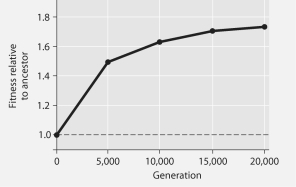Multiple Choice
The following questions refer to Figure 27.1 below, which is the same as Figure 27.10 in the textbook.
In this 8-year experiment, 12 populations of E. coli, each begun from a single cell, were grown in low-glucose conditions for 20,000 generations. Each culture was introduced to fresh growth medium every 24 hours. Occasionally, samples were removed from the populations, and their fitness in low-glucose conditions was tested against that of members sampled from the ancestral (common ancestor) E. coli population.

Figure 27.1
-If the vertical axis of Figure 27.1 refers to "Darwinian fitness," then which of these is the most valid and accurate measure of fitness?
A) number of daughter cells produced per mother cell per generation
B) amount of ATP generated per cell per unit time
C) average swimming speed of cells through the growth medium
D) amount of glucose synthesized per unit time
E) number of generations per unit time
Correct Answer:

Verified
Correct Answer:
Verified
Q4: Nitrogenase, the enzyme that catalyzes nitrogen fixation,
Q9: Which of the following traits do archaeans
Q33: Plantlike photosynthesis that releases O₂ occurs in<br>A)
Q44: Match the numbered terms to the descriptions
Q45: Which of the following use light energy
Q47: Jams, jellies, preserves, honey, and other foodstuffs
Q49: The typical prokaryotic flagellum features<br>A)an internal 9
Q50: Match the numbered terms to the descriptions
Q51: Cyanobacteria are<br>A)photoautotrophs.<br>B)photoheterotrophs.<br>C)chemoautotrophs.<br>D)chemoheterotrophs that perform decomposition.<br>E)parasitic chemoheterotrophs.
Q53: What is the primary ecological role of